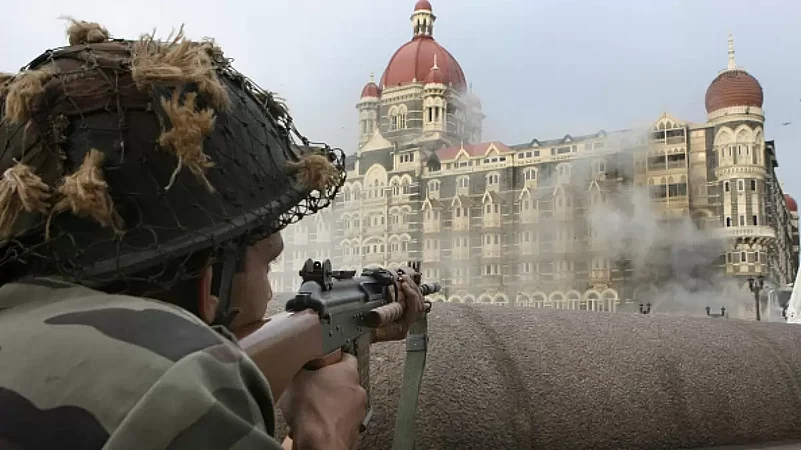A US court has approved the extradition of Pakistani-origin Tahawwur Rana to India. He is wanted for alleged role in 26/11 Mumbai terrorist attacks.
Rana can appeal the order but the higher court is likely to uphold the order. The final authority in such cases rests with the US Secretary of State.
While India blames Pakistan-based terrorist elements for the Mumbai terrorist attacks, the role of US-based elements has also surfaced who are associated with Pakistanis. These individuals are Rana and Pakistani-American David Coleman Headley.
While Headley cannot be extradited to India as per his plea deal with US authorities, Rana can be extradited as per the India-US extradition treaty. India had filed for his extradition in 2020.
Here we explain who is Tahawwur Rana, what's his alleged role in 26/11 attacks, and who all are understood to be behind the attacks.
What happened during 26/11 Mumbai attacks?
A series of terrorist attacks that began on the evening of November 26, 2008 in Maharashtra's Mumbai are called 26/11 attacks.
Ten terrorists reached Mumbai from Pakistan via sea-route and mounted a series of attacks, killing at least 174 people, including 26 foreigners.
The terrorists from Pakistan-based Lashkar-e-Taiba (LeT) selected targets for their symbolic values, striking at the iconic Taj Mahal Palace Hotel and Jewish centre of Nariman House. India and Israel are the main enemies of LeT.
The South Asia Terrorism Portal (SATP) notes, "Hafiz Saeed, a scholar of Islam, has said that the purpose of Jihad is to carry out a sustained struggle for the dominance of Islam in the entire world and to eliminate the evil forces and the ignorant. He considers India, Israel and US to be his prime enemies and has threatened to launch Fidayeen (suicide squad) attacks on American interests too."
Saeed is the founder of LeT. He is a United Nations (UN)-designated terrorist.
In Mumbai, the LeT terrorists attacked Chhatrapati Shivaji Railway Station, Leopold Cafe, Cama Hospital, Nariman House, and Oberoi Trident and Taj Mahal Palace hotels.
After landing in Mumbai, the terrorists divided themselves in groups to carry out separate attacks. One terrorist, Ajmal Amir Kasab, was caught alive and was instrumental in unravelling the Pakistan-based terror plot.
Who is Tahawwur Rana?
Tahawwur Rana is a Pakistani-origin Canadian businessman. He is 62.
Rana is a former doctor in the Pakistan Army. He was a Captain at the time of leaving the Army.
Rana later became a Canadian citizenship and opened businesses in the United States and used them as a cover for terror activities.
"Rana deserted the military in search of a better life and became a Canadian citizen. He and his family later moved to Chicago, where he opened several businesses," reported The Los Angeles Times.
Rana went to Canada in 1997 and obtained Canadian citizenship in 2001 and ran a flourishing immigration consultancy business, according to Rediff News.
Rana was convicted in 2011 in the United States for a plot targeting Danish newspaper over cartoons of Prophet Mohammed, but was cleared of 26/11-related charges at the time.
Rana is also linked to Pakistani-American David Coleman Headley, who visited India and helped plan the Mumbai terror attacks. Headley was a key witness in securing Rana's conviction in the Danish paper plot.
"The Copenhagen newspaper was intended to be targeted as retaliation for publishing cartoon caricatures of the prophet Muhammad. Rana's childhood friend — and the government's star witness — testified that the staff was to be beheaded and tossed out windows. That attack was never carried out," reported LA Times, adding that Headley used the cover of Rana's business to travel to Denmark and India to plan attacks.
Rana was eventually sentenced to 14 years imprisonment in 2013.
US Magistrate Judge Jacqueline Chooljian of the District Court of the Central District of California issued a 48-page order dated May 16, which was released Wednesday, saying Rana "should be extradited to India" under the extradition treaty between India and the United States.
Rana is currently in the federal lockup in downtown Los Angeles. He can appeal in the Circuit Court, which will likely affirm the district court order. Under US law, Secretary of State is the authority who decides whether to surrender the fugitive.
Citing its reasoning in detail, the court order states, "Accordingly, the court finds there is probable cause to believe Rana committed the charged offences as to which extradition has been sought and should be extradited to India under the extradition Treaty between the United States and India."
Tahawwur Rana's role in 26/11 attacks
Tahawwur Rana is linked to Pakistani-American David Coleman Headley, who helped plan the 26/11 Mumbai attacks.
The LA Times reported that Headley told the court that Rana let him use his business as a cover to travel to India and plan Mumbaia ttacks.
"Headley, whose credibility was at issue during the trial, testified that he worked for Lashkar scouting out locations for the Mumbai attacks and also participating in discussions about the plot to attack the Copenhagen newspaper. He testified that Rana helped him obtain a visa and allowed him to open a Mumbai-based office using the name of Rana's company — First World Immigration Services Inc. — which enabled Headley to travel on scouting missions without raising suspicion," reported LA Times.
The Print reported that Headley had briefed Rana about his scouting in Mumbai and that top Lashkar plans in Pakistan were also aware of Rana.
"Tahawwur was also told about Headley’s work to select a landing site for the attackers. Among other things, the FBI said, Major Iqbal had emailed Tahawwur to help facilitate the setting up of a new First World Immigration office in New Delhi, to help Headley surveil targets," reported The Print.
Major Iqbal is a senior Pakistani intelligence officer who is understood to have trained Headley in tradecraft and was involved in 26/11 attacks.
Headley was sentenced to 35 years in prison in 2013. The lower sentence is on account of his cooperation with the US authorities.
(With PTI inputs)
















